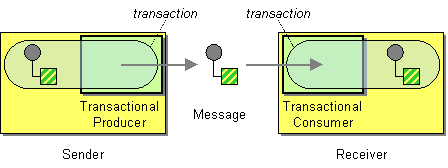Transactional Client
Camel recommends supporting the Transactional Client from the EIP patterns using spring transactions.
Transaction Oriented Endpoints (Camel Toes) like JMS support using a transaction for both inbound and outbound message exchanges. Endpoints that support transactions will participate in the current transaction context that they are called from.
You should use the SpringRouteBuilder to setup the routes since you will need to setup the spring context with the TransactionTemplates that will define the transaction manager configuration and policies.
For inbound endpoint to be transacted, they normally need to be configured to use a Spring PlatformTransactionManager. In the case of the JMS component, this can be done by looking it up in the spring context.
You first define needed object in the spring configuration.
<bean id="jmsTransactionManager" class="org.springframework.jms.connection.JmsTransactionManager">
<property name="connectionFactory" ref="jmsConnectionFactory" />
</bean>
<bean id="jmsConnectionFactory" class="org.apache.activemq.ActiveMQConnectionFactory">
<property name="brokerURL" value="tcp://localhost:61616"/>
</bean>
Then you look them up and use them to create the JmsComponent.
PlatformTransactionManager transactionManager = (PlatformTransactionManager) spring.getBean("jmsTransactionManager");
ConnectionFactory connectionFactory = (ConnectionFactory) spring.getBean("jmsConnectionFactory");
JmsComponent component = JmsComponent.jmsComponentTransacted(connectionFactory, transactionManager);
component.getConfiguration().setConcurrentConsumers(1);
ctx.addComponent("activemq", component);
Transaction Policies
Outbound endpoints will automatically enlist in the current transaction context. But what if you do not want your outbound endpoint to enlist in the same transaction as your inbound endpoint? The solution is to add a Transaction Policy to the processing route. You first have to define transaction policies that you will be using. The policies use a spring TransactionTemplate to declare the transaction demarcation use. So you will need to add something like the following to your spring xml:
<bean id="PROPAGATION_REQUIRED" class="org.springframework.transaction.support.TransactionTemplate">
<property name="transactionManager" ref="jmsTransactionManager"/>
</bean>
<bean id="PROPAGATION_NOT_SUPPORTED" class="org.springframework.transaction.support.TransactionTemplate">
<property name="transactionManager" ref="jmsTransactionManager"/>
<property name="propagationBehaviorName" value="PROPAGATION_NOT_SUPPORTED"/>
</bean>
<bean id="PROPAGATION_REQUIRES_NEW" class="org.springframework.transaction.support.TransactionTemplate">
<property name="transactionManager" ref="jmsTransactionManager"/>
<property name="propagationBehaviorName" value="PROPAGATION_REQUIRES_NEW"/>
</bean>
Then in your SpringRouteBuilder, you just need to create new SpringTransactionPolicy objects for each of the templates.
public void configure() {
...
Policy requried = new SpringTransactionPolicy(bean(TransactionTemplate.class, "PROPAGATION_REQUIRED"));
Policy notsupported = new SpringTransactionPolicy(bean(TransactionTemplate.class, "PROPAGATION_NOT_SUPPORTED"));
Policy requirenew = new SpringTransactionPolicy(bean(TransactionTemplate.class, "PROPAGATION_REQUIRES_NEW"));
...
}
Once created, you can use the Policy objects in your processing routes:
// Send to bar in a new transaction
from("activemq:queue:foo").policy(requirenew).to("activemq:queue:bar");
// Send to bar without a transaction.
from("activemq:queue:foo").policy(notsupported ).to("activemq:queue:bar");
See Also
Using This Pattern
If you would like to use this EIP Pattern then please read the Getting Started, you may also find the Architecture useful particularly the description of Endpoint and URIs. Then you could try out some of the Examples first before trying this pattern out.
